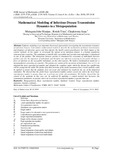| dc.contributor.author | Mutuguta, John W. | |
| dc.contributor.author | Rotich, T. | |
| dc.contributor.author | Chepkwony, I. | |
| dc.date.accessioned | 2019-11-26T11:34:38Z | |
| dc.date.available | 2019-11-26T11:34:38Z | |
| dc.date.issued | 2019-11 | |
| dc.identifier.citation | IOSR Journal of Mathematics (IOSR-JM) e-ISSN: 2278-5728, p-ISSN: 2319-765X. Volume 15, Issue 6 Ser. II (Nov – Dec 2019), PP 18-36 | en_US |
| dc.identifier.uri | http://hdl.handle.net/123456789/4380 | |
| dc.description.abstract | Epidemic modeling is an important theoretical approach for investigating the transmission dynamics of infectious diseases. It formulates mathematical models to describe the mechanisms of disease transmissions and dynamics of infectious agents and then informs the health control practitioners the likely impact of the control methods. In this paper we investigate the spread of an infectious disease in a human population structured into n-patches. The population is initially fully susceptible until an infectious individual is introduced in one of the patches. The interaction between patches is dominated by movement of individuals between patches and also the migration of individuals and therefore any infection occurring in one patch will have a force of infection on the susceptible individuals on the other patches. We build a mathematical model for a metapopulation consisting of 𝑛 patches. The patches are connected by movement of individuals. For 𝑛 = 2, we obtained the basic reproduction number and obtained the condition under which the disease free equilibrium will be asymptotically stable. We further described in terms of the model parameters how control methods could be applied to ensure that the epidemic does not occur and validated the results by the use of the numerical simulation. We showed that the global basic reproduction number cannot exceed one unless the local basic reproduction number is greater than one in at least one of the sub-populations. We further showed that the control of the epidemic in this case can be achieved by applying a control method that decreases the transmission parameters in patches where the local basic reproduction number is greater than one. | en_US |
| dc.language.iso | en | en_US |
| dc.publisher | iosr journals | en_US |
| dc.subject | Metapopulation | en_US |
| dc.subject | Basic reproduction number | en_US |
| dc.subject | Epidemic Control | en_US |
| dc.subject | Target reproduction number | en_US |
| dc.subject | migration | en_US |
| dc.subject | Lipchitz continuity | en_US |
| dc.subject | Mathematics Subject Classification: 97M60, 00A71, 92A07, 92D30 | en_US |
| dc.title | Mathematical Modeling of Infectious Disease Transmission Dynamics in a Metapopulation | en_US |
| dc.type | Article | en_US |

